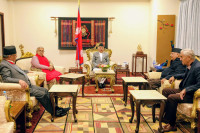Opinion
It’s not Snake oil
Nepal is not known for applying social science in policy-making, and we are much the poorer for that
Deepak Thapa
A few months ago, the Chief Justice of the United States Supreme Court, John Roberts, made a somewhat off-the-cuff remark during a hearing that reverberated for a bit in academic circles. Having heard social scientific evidence on how gerrymandering worked to disenfranchise a significant section of the voting population, Roberts said: ‘[I]t may be simply my educational background, but I can only describe [the social science data] as sociological gobbledygook.’
Roberts prefaced that remark with reference to what might be called the ‘man-on-the-street’ test whereby he attempted to show what the fairly complex scientific concept presented to the court would seem to such an individual: ‘And if you’re the intelligent man on the street and the Court issues a decision, and let’s say, okay, the Democrats win, and that person will say: “Well, why did the Democrats win?” And the answer is going to be because EG [efficiency gap] was greater than 7 percent, where EG is the sigma of party X wasted votes minus the sigma of party Y wasted votes over the sigma of party X votes plus party Y votes. And the intelligent man on the street is going to say that’s a bunch of baloney. It must be because the Supreme Court preferred the Democrats over the Republicans.’
Within days, the President of the American Sociological Association had shot off a letter to Roberts, expressing concern that ‘a person of your stature suggesting to the public that scientific measurement is not valid or reliable and that expertise should not be trusted. What you call “gobbledygook” is rigorous and empirical’. The letter added a personal twist as well that ‘social scientists and legal scholars at your alma mater would be disappointed to learn that you attributed your lack of understanding of social science to your Harvard education. Should you be interested in enhancing your education in this area, we would be glad to put together a group of nationally and internationally renowned sociologists to meet with you and your staff.’
Unscientific Nepalis
It is not known whether Chief Justice Roberts has taken up that offer or not. But it does lead one to wonder what role social science plays in our own country’s policy-making. The years since 2006 have seen Nepal undergo momentous changes in practically every sphere of life. Almost all of these were driven by politics and while the result has been that the state has become much more responsive to the people, the use of social science in the realm of policy-making appears rather thin. The one major exception perhaps was the ‘Gender and Social Exclusion Assessment’ from the mid-2000s, which brought together a host of, mainly Nepali, social scientists tracing the sources of exclusion in Nepali society. Backed as the assessment was by the World Bank and the United Kingdom’s Department for International Development, it was able to set the tone for devising still-extant inclusive government policies.
But, that study was a product of the times when a New Nepal was being envisaged, and its findings were readily accepted by most political actors. The congenial atmosphere degenerated quickly after 2006, particularly over the twin issues of the Tarai and ethno-federalism, and ever since politics has held sway over other kinds of evidence. The most blatant instance was the proposal around the time of the adoption of the constitution in 2015 to divide the country into six provinces, but which quickly became seven provinces after protests broke out. Apart from political expediency, we were not provided any reasons as to why the six had been decided on, nor why the seven was acceded to.
It’s all Greek
The absence of use of evidence goes down to a more fundamental level though. For all the social scientific production every year in Nepal, there appears little uptake in policy circles. That is partly only to be expected since scholarly work can be quite abstruse due to the language in which it is presented. However, the reception of more accessible outputs that are only informed by social science is also abysmal despite their obvious value. It could be that there are those in positions of authority who also view such works as nothing more than ‘sociological gobbledegook’ but it often appears to be the case that such individuals either do not have the time or profess not to, or lack the inclination to learn something new.
And, then there are the naysayers, who have the misplaced expectation that every bit of research will come up with some ground-breaking findings. The social science project, after all, is rooted in social reality, and usually goes no further than collecting available data in a scientific manner and interpreting it to provide insights that may or may not be previously unknown. Its value lies in this this systematic collection of facts that can also be used as evidence to drive policy. Take the example of something like Unravelling the Mosaic: Spatial Aspects of Ethnicity in Nepal (2008) by geographer Pitamber Sharma. Anyone who knows Nepal even a tiny bit knows the scale of the country’s ethnic diversity, and so would not be surprised by what Sharma laid out in his book. But, it was the presentation of the census data through the effective use of maps that made the volume stand out.
Not every publication has to be like the 1980 publication, Nepal in Crisis: Growth and Stagnation at the Periphery by Piers Blaikie, John Cameron and David Seddon, a volume that continues to resonate in Nepal studies, and still ring true in many respects. I was still in high school when it was published but I had heard then that it had been made mandatory reading by King Birendra for all his top bureaucrats. Seeing that not much changed in the 10 years since its publication and the end of the Panchayat system, perhaps for most officials, and there were many more at that time who came from Sanskrit education, the book stood as a prime example of ‘sociological gobbledegook’.
In many of our government departments, particularly having to do with infrastructure development, can be found people known as sociologists. These are individuals tasked with dealing with local communities and ensuring that social protection measures designed for development projects are adhered to. Sometimes, they also collect their own data and provide interpretations to facilitate the progress of the project. These ‘sociologists’ are not necessarily people with a background in sociology but can generally be from any social science degree. But, perhaps because engineer-heavy offices conflate social science with sociology, most continue to be known as sociologists. One only hopes that the bosses of these organisations are not inclined to agreeing with Chief Justice Roberts’ summary dismissal of social science per se. The country would be all the poorer for that.




 11.12°C Kathmandu
11.12°C Kathmandu











